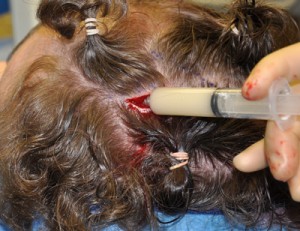The skull develops its shape from a variety of influences including genetics, sutural development, the growth of the underlying brain and external molding forces. While the shape of the skull has recognizeable normal characteristics, it is prone to wide variations in its dimensions and no two people have exactly the same looking head. But, in general, most skulls have relatively smooth convex surfaces.
But not every skull is completely smooth and many people have small lumps and bumps on their skull. Such findings are so common that a whole field of pseudoscience that was very popular in the 19th century, Phrenology, developed around the interpretation of a person’s psychological attributes based on these skull contour irregularities. While Phrenology has long been discredited as having any relevance to a person’s psychological make-up, some of a skull’s ‘high and low’ spots are aesthetically bothersome to some people.
While a skull can have raised areas (e.g., osteoma), it is also prone to indentations or dimples. Skull dimples occur most commonly in the remnant location of the original fontanelles. Fontanelles or soft spots are where open spots existed as spaces between the incompletely formed skull bones in neonates and infants. Everyone at one time has felt the anterior and posterior soft spots on a baby’s head. (and the pulsating beat of the brain) While the anterior fontanelle eventually closes at 9 to 18 months after birth, the posterior fontanelle closes much more quickly within the first few months after birth.
While the soft spot on a baby’s head may make it seem to be susceptible to a potential brain injury because of the lack of bone, the fontanelle is covered with a really tough membrane that is not easily penetrated. But this tough membrane can occasionally impede bone from achieving a normal thickness as it ossifies. This then leaves a small crater or indentation (dimple) where the original fontanelle space was. Why it occurs more commonly at the location of the posterior fontanelle, which closes much sooner, is not known.

Skull dimpleplasty is a very simple and effective skull reshaping technique for small indentations/dimples. It is quick and easy to do and the plug of material is easily pressed flat and smooth over the dimple.
Dr. Barry Eppley
Indianapolis, Indiana


